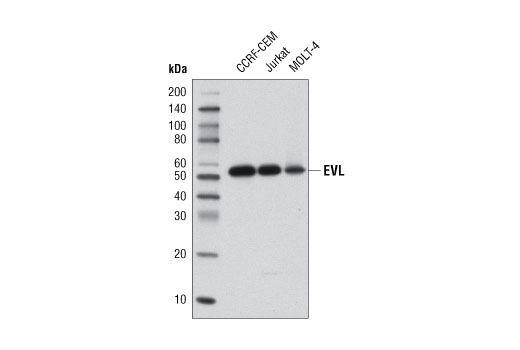WB, IP
H
Endogenous
52
Rabbit
#Q9UI08
51466
Product Information
Product Usage Information
| Application | Dilution |
|---|---|
| Western Blotting | 1:1000 |
| Immunoprecipitation | 1:50 |
Storage
Specificity / Sensitivity
Species Reactivity:
Human
Source / Purification
Polyclonal antibodies are produced by immunizing animals with a synthetic peptide corresponding to residues surrounding Ser362 of human EVL protein. Antibodies are purified by protein A and peptide affinity chromatography.
Background
Ena/VASP-like (EVL) protein is a member of the Ena/VASP family and is involved in actin-associated cytoskeleton remodeling and cell polarity activities including axon guidance and lamellipodia formation in migrating cells (1,2,3). The EVL protein sequence contains an N-terminal EVH1 domain, a Pro-rich SH3 binding domain, and a C-terminal EVH2 domain. EVL domain interactions with G- and F-actin mediates actin nucleation and polymerization (4). Research studies have shown that EVL also regulates DNA repair by direct interaction with RAD51 (5). EVL may function in the DSB repair pathway through the EVH2 domain, which possesses DNA-binding and RAD51 binding activity, thereby coordinating homologous DNA recombination (6,7). Research studies have shown EVL expression is up-regulated in human breast cancer associated with clinical stages and may be implicated in invasion and/or metastasis of human breast cancer (8).
- Michael, M. et al. (2010) Curr Biol 20, 783-91.
- Goh, K.L. et al. (2002) Curr Biol 12, 565-9.
- Lebrand, C. et al. (2004) Neuron 42, 37-49.
- Laurent, V. et al. (1999) J Cell Biol 144, 1245-58.
- Takaku, M. et al. (2009) J Biol Chem 284, 14326-36.
- Takaku, M. et al. (2011) J Biochem 149, 721-9.
- Takaku, M. et al. (2009) FEBS J 276, 5841-8.
- Hu, L.D. et al. (2008) Oncol Rep 19, 1015-20.
Species Reactivity
Species reactivity is determined by testing in at least one approved application (e.g., western blot).
Western Blot Buffer
IMPORTANT: For western blots, incubate membrane with diluted primary antibody in 5% w/v BSA, 1X TBS, 0.1% Tween® 20 at 4°C with gentle shaking, overnight.
Applications Key
WB: Western Blotting IP: Immunoprecipitation
Cross-Reactivity Key
H: human M: mouse R: rat Hm: hamster Mk: monkey Vir: virus Mi: mink C: chicken Dm: D. melanogaster X: Xenopus Z: zebrafish B: bovine Dg: dog Pg: pig Sc: S. cerevisiae Ce: C. elegans Hr: horse GP: Guinea Pig Rab: rabbit All: all species expected
Trademarks and Patents
Limited Uses
Except as otherwise expressly agreed in a writing signed by a legally authorized representative of CST, the following terms apply to Products provided by CST, its affiliates or its distributors. Any Customer's terms and conditions that are in addition to, or different from, those contained herein, unless separately accepted in writing by a legally authorized representative of CST, are rejected and are of no force or effect.
Products are labeled with For Research Use Only or a similar labeling statement and have not been approved, cleared, or licensed by the FDA or other regulatory foreign or domestic entity, for any purpose. Customer shall not use any Product for any diagnostic or therapeutic purpose, or otherwise in any manner that conflicts with its labeling statement. Products sold or licensed by CST are provided for Customer as the end-user and solely for research and development uses. Any use of Product for diagnostic, prophylactic or therapeutic purposes, or any purchase of Product for resale (alone or as a component) or other commercial purpose, requires a separate license from CST. Customer shall (a) not sell, license, loan, donate or otherwise transfer or make available any Product to any third party, whether alone or in combination with other materials, or use the Products to manufacture any commercial products, (b) not copy, modify, reverse engineer, decompile, disassemble or otherwise attempt to discover the underlying structure or technology of the Products, or use the Products for the purpose of developing any products or services that would compete with CST products or services, (c) not alter or remove from the Products any trademarks, trade names, logos, patent or copyright notices or markings, (d) use the Products solely in accordance with CST Product Terms of Sale and any applicable documentation, and (e) comply with any license, terms of service or similar agreement with respect to any third party products or services used by Customer in connection with the Products.

